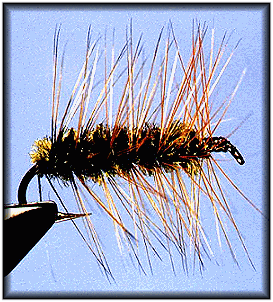If you like top-water action, the prespawn is for you. The big 'gills
are roaming and really working the surface. However, once the spawn
begins, it can be harder to entice those big full up and away from the
next, especially if they are in fairly deep water.
If you have been catching with top water poppers and the action stops,
you might do better switching to some type of wet fly. I almost always
go with a woolly worm. I let the worm sink ever so slowly and barely
twitch it. The worm appears to be suspended in the water. You can
use this method with or without weight; it just depends on your patience.

I prefer not using any weight, because if the fish just mouths the fly,
I prefer it not feel resistance from the line. If the big fish are nesting
in several feet of water, however, I do add some weight. It seems to
take forever for a weightless wooly worm to sink to the bottom.
Post spawn requires different techniques. Water temperature effects fishing
success, as do changes in the weather. When the water is warm, the spring
day sunny and hot, bluegills, like so many other fish, move into the shallows.
This is especially true early morning and late evening.
I prefer to fish some type of terrestrial over or near cover at this time.
Ant and mosquito imitations work great, especially if the fish are holding
near the bank. Look for any kind of food falling into the water. If anything
in your vest resembles it, tie it on.
If you fish during the heat of the day after the spawn, then you most likely
must go deep to find the big fish. Weighted wooly worms, again, are
attractive. Cricket and ant imitations also work well. I have caught some
huge bluegills on small bumblebee imitations. Try something new, and see
what happens.
Catching bluegills on fly-fishing gear is easy; catching big bluegills is more
of a challenge. But once you have done your homework and are presenting
the right flies in the right situations, the catching can be the easiest part.
~ Kevin Wright
|

